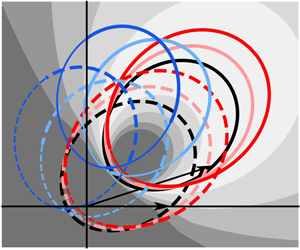Published online by Cambridge University Press: 22 January 2021

The Hasselmann kinetic equation (HKE) forms the cornerstone of present-day spectral wave models. It describes the redistribution of energy over the wave spectrum as a result of resonant four-wave interactions, and theoretically prescribes wave evolution on a slow  $O(1/\varepsilon ^4\omega _0)$ time scale, where
$O(1/\varepsilon ^4\omega _0)$ time scale, where  $\varepsilon$ and
$\varepsilon$ and  $\omega _0$ are typical wave steepness and frequency. Alternatives to the HKE (e.g. the generalized kinetic equation (GKE)), including the effects of non-resonant four-wave interactions, are believed capable of evolving wave fields on a fast
$\omega _0$ are typical wave steepness and frequency. Alternatives to the HKE (e.g. the generalized kinetic equation (GKE)), including the effects of non-resonant four-wave interactions, are believed capable of evolving wave fields on a fast  $O(1/\varepsilon ^2\omega _0)$ time scale. It is beyond doubt that these alternatives could reasonably predict changes of unidirectional waves whereas the HKE cannot. For angular spread wave fields, however, it is still ambiguous whether the GKE behaves remarkably differently from the HKE because previous research in this direction was not fully consistent. In this study, we revised the GKE algorithm implemented in the spectral wave model WAVEWATCH III (WW3) by correcting two numerical aspects related to the discretization of the GKE and to the source term integration. It is proved that once updated, the GKE in WW3 does not give rise to significant deviation from the HKE-based results, provided that the wave spectra are fairly smooth and the directionality is sufficiently broad. These results, although unexpected, are in good agreement with findings reported by Annenkov & Shrira. More strikingly, the HKE and GKE are observed to operate at the same fast
$O(1/\varepsilon ^2\omega _0)$ time scale. It is beyond doubt that these alternatives could reasonably predict changes of unidirectional waves whereas the HKE cannot. For angular spread wave fields, however, it is still ambiguous whether the GKE behaves remarkably differently from the HKE because previous research in this direction was not fully consistent. In this study, we revised the GKE algorithm implemented in the spectral wave model WAVEWATCH III (WW3) by correcting two numerical aspects related to the discretization of the GKE and to the source term integration. It is proved that once updated, the GKE in WW3 does not give rise to significant deviation from the HKE-based results, provided that the wave spectra are fairly smooth and the directionality is sufficiently broad. These results, although unexpected, are in good agreement with findings reported by Annenkov & Shrira. More strikingly, the HKE and GKE are observed to operate at the same fast  $O(1/\varepsilon ^2\omega _0)$ time scale for the spectral peak downshift and angular broadening, indicating that the HKE, solved by the well-established Webb–Resio–Tracy algorithm, seems more robust than usually expected.
$O(1/\varepsilon ^2\omega _0)$ time scale for the spectral peak downshift and angular broadening, indicating that the HKE, solved by the well-established Webb–Resio–Tracy algorithm, seems more robust than usually expected.